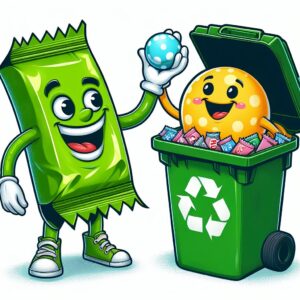To grasp the challenges and possibilities of recycling chewing gum, it’s necessary to understand what it’s made of. The gum base was derived from chicle, a natural rubber from the sapodilla tree. Most chewing gums are made from synthetic rubbers, making them more durable but also more of a headache to dispose of properly. These synthetic components mixed with sweeteners, flavorings, and softeners create a non-biodegradable product that clings to surfaces and resists easy removal.
The Sticky Issue at Hand
Chewing gum persists in the environment, clinging to pavements, park benches, and other public infrastructures. This creates an unpleasant urban environment, detracting from the cleanliness and appearance of communal spaces. The effort and resources required to remove gum from these surfaces are significant. Urban cleaning crews often must resort to using specialized equipment to remove gum, incurring considerable expense and diverting resources from other important services.
Beyond the immediate impact on urban spaces, the widespread disposal of chewing gum in the environment raises concerns about its contribution to the broader issue of non-biodegradable waste. As cities around the globe grapple with challenges related to waste management and sustainability, finding solutions to manage and mitigate the impact of such materials has become imperative.
It calls for greater public awareness about the environmental impact of improperly disposed chewing gum. Educational campaigns can highlight the social and economic costs associated with cleaning and maintenance. Encouraging responsible disposal and providing appropriate facilities for gum disposal are practical steps that can significantly mitigate the problem.
Exploring innovative recycling solutions offers a promising avenue for addressing this challenge. Transforming waste gum into new products contributes to the circular economy, adding value and encouraging sustainable production and consumption practices.
 The Potential of Recycling Programs
The Potential of Recycling Programs
The potential of these programs lies in their ability to transform a prevalent waste product into useful materials. Chewing gum, when recycled, can serve as a raw material for the production of a variety of new products. This contributes to the reduction of new resources being extracted for manufacturing processes.
Recycled gum has been transformed into a range of items, from footwear and mobile phone covers to composites used in industrial applications. Such diversity in potential end products increases the viability and appeal of recycling initiatives, offering tangible examples of how traditionally non-recyclable materials can be repurposed.
By converting waste into valuable products, recycling programs can stimulate local economies, foster innovation, and create new job opportunities in the recycling and manufacturing sectors. They can lead to savings for municipal services by reducing the need for intensive cleaning operations to remove gum from public areas.
For such initiatives to reach their potential, individuals must be inclined to dispose of their gum responsibly at designated collection points. Public education campaigns and the convenient placement of collection bins are critical in facilitating this shift in behavior.
In embracing the potential of recycling programs, stakeholders including local governments, environmental organizations, and the gum manufacturing industry itself, have a unique opportunity to collaborate. They can develop strategies that promote sustainable practices and circular economy principles.
Overcoming the Hurdles
The logistical challenges begin with the collection of used chewing gum, which is scattered across vast urban spaces and often found in hard-to-reach places. Developing an efficient and effective collection system is paramount for the success of any recycling program. This could involve the strategic placement of specialized gum disposal bins in high-traffic areas and public education campaigns to encourage their use. Equally important is the process of transforming the collected gum into a usable recycled material. The technological and process innovations in this area could significantly reduce the energy and resources required, making recycling more viable and environmentally beneficial.
The costs associated with the collection, processing, and manufacturing of products from recycled gum must be balanced against the revenue generated from the sale of these products. For recycling programs to be sustainable in the long term, they need to operate within a model that is financially viable. This may involve finding markets where recycled gum products can command a premium due to their environmental credentials or leveraging partnerships with corporations keen on showcasing their commitment to sustainability.
Changing people’s habits regarding gum disposal requires a shift in cultural attitudes towards waste and recycling. Effective communication strategies are critical in achieving this, highlighting the negative impacts of improper gum disposal and the benefits of recycling. Engaging the community through educational programs, incentives for responsible disposal, and public-private partnerships can foster a culture of recycling and environmental stewardship.
Case Studies and Examples
One noteworthy example is the initiative undertaken by Gumdrop Ltd in the United Kingdom. Founded with the mission to tackle the global problem of chewing gum litter, Gumdrop provides specially designed bins – Gumdrop Bins – for the disposal of used gum. Once collected, the gum is recycled into a range of products, including footwear, cups, and composites used in various manufacturing sectors. This initiative provides a blueprint for closed-loop recycling, turning a waste product into something usable again.
The city of Milan in Italy partnered with a chewing gum manufacturer to launch a public awareness campaign aimed at reducing gum litter. The campaign included the installation of dedicated gum recycling bins throughout the city. The collected gum was then recycled into rubber mats for public sports facilities, demonstrating a creative and community-focused solution to the gum litter problem.
In the Netherlands, a project known as Gumshoe emerged, where recycled chewing gum was used to produce the soles of sneakers. The initiative aimed to highlight the issue of gum litter in an innovative way, engaging consumers directly by offering them a product made from recycled gum. This project raised awareness about recycling and sustainability uniquely.



